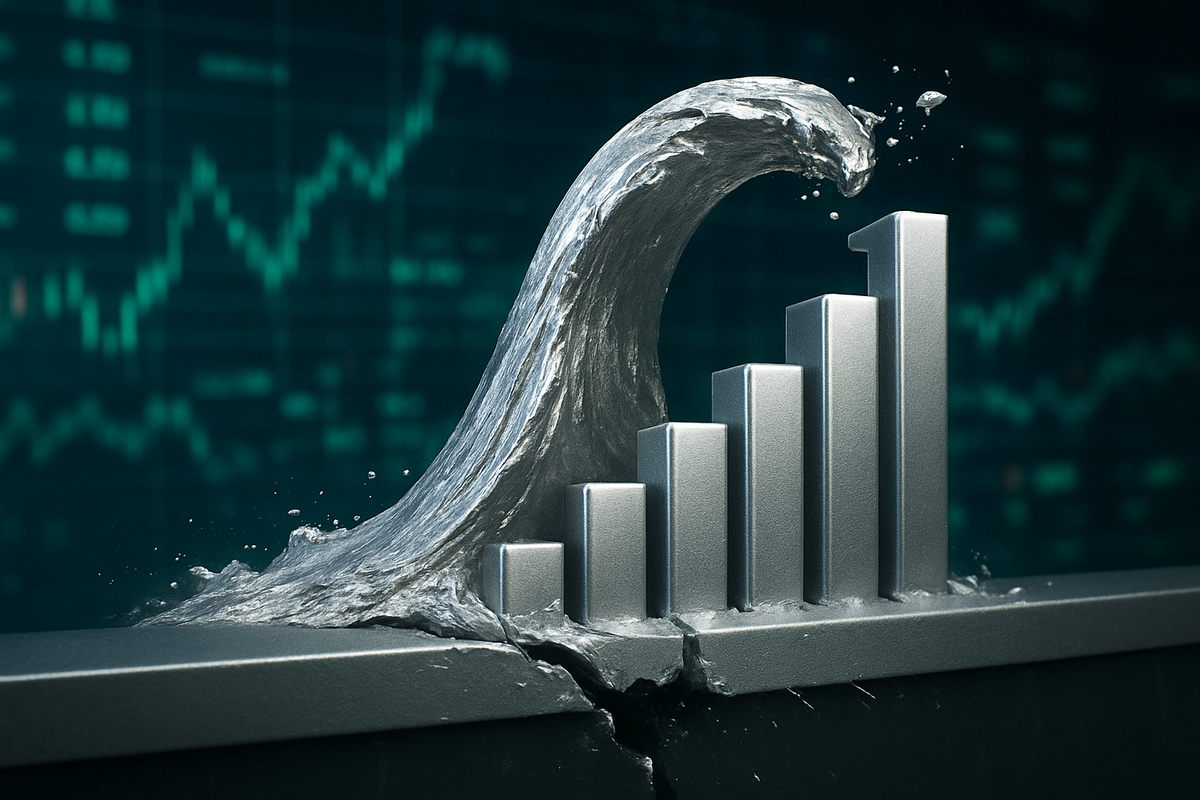
The global financial markets are buzzing with increased scrutiny on silver, as a confluence of factors points towards a heightened risk of a significant commodity short squeeze. This phenomenon, if it fully materializes, could trigger unprecedented price surges, sending ripples across industrial supply chains and reshaping investment strategies. With the current date being October 17, 2025, the market is already witnessing intense volatility and record-breaking price movements in silver, signaling that the squeeze may not just be a warning, but an ongoing reality.
A commodity short squeeze occurs when the price of an asset rises sharply, forcing investors who have bet against it (short sellers) to buy it back to limit their losses. This forced buying creates a self-reinforcing upward spiral, accelerating the price increase and exacerbating the squeeze. For silver, this scenario is particularly potent due to a unique imbalance between the vast volume of "paper" silver traded in derivatives markets and the comparatively limited physical metal available for delivery, coupled with robust demand from both investment and industrial sectors.
Understanding the Silver Squeeze: A Deep Dive into Market Dynamics
The current situation in the silver market is a complex interplay of fundamental supply-demand dynamics and structural vulnerabilities. At its core, a short squeeze is a market event where a rapid increase in price compels short sellers to repurchase the underlying asset to cover their positions, thereby fueling further price escalation. Short selling involves borrowing an asset, selling it, and hoping to buy it back at a lower price to profit from the difference. When the price moves against short sellers, their losses can be theoretically unlimited, leading to a frantic scramble to cover positions.
Silver's susceptibility to such a squeeze stems from several critical factors. Firstly, there's a significant disparity between the volume of physical silver and the much larger "paper" claims through futures contracts and other derivatives. This structural imbalance means that even a moderate increase in physical demand can disproportionately impact prices in the paper market. Secondly, major institutional players, including hedge funds and bullion banks, often hold substantial short positions in COMEX silver futures, leaving them vulnerable to rising prices and margin calls. Thirdly, unlike gold, which benefits from extensive central bank reserves, silver lacks substantial government stockpiles that could be deployed to stabilize prices, leaving the market more exposed to supply-demand shocks. Furthermore, silver's dual role as both a precious metal and a vital industrial commodity—essential for solar panels, electric vehicles, and electronics—creates a "perfect storm" when industrial consumption is robust and investment demand surges. Recent reports indicate acute shortages of physical silver in key trading hubs like London, with physical metal commanding significant premiums and lease rates for borrowing silver reaching extraordinary levels, reflecting severe scarcity and market stress.
The timeline leading up to this moment has been characterized by a growing recognition of these underlying vulnerabilities. Throughout 2025, spot silver prices have surged past $50 per ounce, even touching highs of $53.62 and $54.49, representing a staggering year-to-date gain of approximately 70-83%. This dramatic price action is a direct consequence of the aforementioned factors. Key players involved include large institutional short sellers, retail investors driving demand for physical silver, and industrial consumers grappling with rising input costs. Initial market reactions have been overwhelmingly bullish, with silver significantly outperforming gold and major global stock indices. Investment demand is robust, driven by silver's perceived affordability as a safe-haven asset amidst geopolitical uncertainties and inflation concerns. This bullish sentiment is further reinforced by persistent supply deficits, with the silver market in its fifth consecutive year of deficit, projecting a shortfall of around 118 million ounces in 2025.
Corporate Fortunes: Winners and Losers in a Soaring Silver Market
A silver short squeeze creates a stark divergence in fortunes across the corporate landscape, impacting mining companies, industrial users, and financial institutions in profound ways. The outcome for individual entities largely depends on their operational structure, hedging strategies, and reliance on silver.
Potential Winners:
Primary silver mining companies with unhedged production are the most significant beneficiaries. These companies realize windfall profits as the spot price of silver soars, leading to significantly improved profit margins and enhanced valuations. Major players poised to win include:
- Fresnillo PLC (LSE: FRES / OTC: FNLPF): As the world's leading silver producer, Fresnillo stands to gain immensely from its extensive reserves and operational capacity.
- Pan American Silver Corp. (TSX: PAAS / NASDAQ: PAAS): One of the largest primary silver producers with operations across the Americas, Pan American Silver would see substantial revenue growth.
- Hecla Mining Company (NYSE: HL): A prominent silver mining company, Hecla is well-positioned to capitalize on higher prices.
- First Majestic Silver Corp. (TSX: FR / NYSE: AG): Operating several wholly-owned silver mines in Mexico, First Majestic Silver, often considered a pure-play silver miner, would experience a dramatic increase in asset values and revenue.
- MAG Silver (TSX: MAG / NYSE American: MAG): Known for its stake in the high-grade Juanicipio Silver Mine.
- Coeur Mining, Inc. (NYSE: CDE): With a primary focus on silver mining across the Americas.
- Endeavour Silver Corporation (TSX: EDR / NYSE: EXK): A mid-tier silver mining company with operations primarily in Mexico. Companies with strong balance sheets and low "all-in sustaining costs" (AISC) per ounce are also well-positioned, as they can generate significant cash flow and fund expansions.
Potential Losers:
Conversely, several entities face significant challenges.
- Heavily Hedged Producers: Mining companies that have extensively hedged their future silver production through forward sales may miss out on the full upside of the price surge, as their profits are capped at lower, pre-squeeze prices.
- Industrial Users: Industries heavily reliant on silver as an input, such as electronics manufacturers, solar panel producers, and medical device companies, face significantly higher input costs and supply uncertainties. The solar industry, in particular, which uses approximately 20 grams of silver per photovoltaic panel, will see increased production costs. These companies may be forced to absorb costs, pass them on to consumers, or accelerate efforts to find silver substitutes, though widespread adoption takes time.
- Financial Institutions and Short Sellers: Large financial institutions and traders holding substantial short positions in silver derivatives face potential losses in the billions. They are compelled to cover their positions at progressively higher prices, compounded by dramatically elevated borrowing costs for physical silver or silver-backed ETF shares, which have surged to 14% annually in recent squeezes. The withdrawal of major banks from market-making can also reduce liquidity, making it harder and more expensive to exit short positions.
Investment vehicles like silver-backed Exchange Traded Funds (ETFs), such as iShares Silver Trust (NYSE Arca: SLV) and Aberdeen Standard Physical Silver Shares ETF (NYSE Arca: SIVR), generally benefit from massive inflows during a squeeze due to increased investment demand. However, the extreme volatility also presents risks if investor sentiment were to reverse suddenly.
Wider Significance: Reshaping Markets and Policy
The potential for a silver short squeeze carries profound wider significance, extending beyond immediate price movements to influence broader industry trends, regulatory landscapes, and global economic stability. It underscores silver's critical dual role and exposes underlying vulnerabilities in the global commodity market structure.
This event fits into broader industry trends by highlighting the increasing importance of critical minerals for the green energy transition. Silver's indispensable role in solar panels, electric vehicles, and 5G technology means its price volatility directly impacts the cost and feasibility of global decarbonization efforts. A squeeze could accelerate the search for material substitutions and enhance recycling efforts across various industries. It also signals a potential shift in market dynamics, where physical market fundamentals gain ascendancy over paper trading, leading to pronounced price divergences between major trading hubs and complex logistical challenges like air-freighting silver bars to capitalize on arbitrage.
The ripple effects are substantial. For other precious metals, a silver squeeze often occurs within a broader bullish trend, pulling up prices for gold, platinum, and palladium as investors seek safe havens. For industrial competitors, higher silver prices could give an advantage to those using alternative materials or those with robust hedging strategies. Regulatory and policy implications are significant. Such a large-scale market disruption is likely to prompt calls for greater transparency and oversight in commodity derivative markets, particularly concerning large short positions. Regulators may re-evaluate market mechanisms to address the imbalance between paper contracts and physical availability, and concerns about "broken" physical trading hubs could lead to reforms. Governments may also increase their focus on resource security and strategic mineral policies, including potential stockpiling, creating sustained demand pressure.
Historically, the most infamous precedent is the 1980 Hunt brothers incident. In 1979-1980, Nelson Bunker Hunt and William Herbert Hunt attempted to corner the silver market, driving prices from approximately $6 to nearly $50 per ounce. Their aggressive accumulation of physical silver and futures contracts ultimately led to regulatory intervention (COMEX's "Silver Rule 7"), massive margin calls they couldn't meet, and a dramatic price collapse on "Silver Thursday," March 27, 1980, when prices plunged from over $40 to $10.80. The Hunt brothers faced billions in losses and eventual bankruptcy. While the 1980 event was largely driven by speculative manipulation, the current 2025 scenario, with spot prices surpassing the 1980 nominal peak, is characterized by structural supply deficits, acute physical shortages, and robust industrial demand, suggesting a more fundamental underpinning than past speculative rallies. The 2021 Reddit-inspired attempt to squeeze silver, though brief, also demonstrated the complexities of such efforts in a large commodity market.
What Comes Next: Navigating a Volatile Future
The silver market, having experienced a significant short squeeze, is entering a new, dynamic phase marked by continued volatility and a fundamental re-evaluation of its value proposition. Both short-term adjustments and long-term strategic pivots will be crucial for all market participants.
In the short term, expect continued extreme price volatility. While the most intense phase of forced short-covering may moderate, silver prices are likely to experience significant daily swings ($5-$10 movements) as the market adjusts to the new equilibrium. Physical market tightness, particularly in key vaults, is expected to persist, leading to continued premiums for physical metal. Liquidity challenges, including wider bid-ask spreads, may also endure as market makers adapt. For miners, this means a continued focus on optimizing production and potentially accelerating development of high-grade projects. Industrial users must prioritize securing long-term supply contracts and exploring immediate hedging solutions to mitigate cost shocks. Investors should brace for heightened risk and employ disciplined risk management strategies.
Looking long-term, the squeeze could fundamentally reset expectations for silver's valuation, solidifying its status as a critical commodity for the green economy and a hedge against global uncertainties. Analysts project further price increases, with some forecasting $65-$75 per ounce in the medium term for 2026, and even higher in the future. The structural deficit, where demand consistently outpaces mine production, is a powerful long-term bullish factor. This will incentivize miners to accelerate exploration and development, although new supply has long lead times (6-12 years). Industrial users will intensify research into material substitution and enhance recycling infrastructure to reduce reliance on primary silver. Investors may re-evaluate silver's strategic importance in diversified portfolios, considering both direct physical ownership and exposure through silver-backed ETFs and mining stocks.
Market opportunities will emerge in innovative recycling technologies, advanced hedging solutions, and investment in silver mining companies with efficient operations. The squeeze may solidify a new paradigm of valuation for silver. However, significant challenges include extreme volatility and potential illiquidity, the risk of demand destruction if prices become unsustainably high, and continued regulatory scrutiny. Unlike gold, the absence of central bank intervention in silver removes a stabilizing force, contributing to more dramatic price movements.
Potential scenarios include a "soft landing" where prices stabilize at a new, higher equilibrium after short positions are covered without major financial contagion, possibly consolidating around $50 per ounce. Alternatively, a "disruptive/exponential phase" could see physical shortages intensify further, leading to even more dramatic and disorderly price spikes. A "regulatory intervention" scenario is also possible, with coordinated actions to restore market order. Finally, a correction followed by a resumption of the rally is plausible, as profit-taking leads to temporary pullbacks before underlying demand and structural deficits push prices higher again.
Wrap-Up: A New Era for Silver
The warning for a silver commodity short squeeze, now largely recognized as an ongoing market event, marks a pivotal moment for the precious metals and industrial commodities landscape. The confluence of a structural supply deficit, surging industrial demand from green technologies, robust investment interest, and significant institutional short positions has created an environment ripe for unprecedented price action. The dramatic price surges observed in 2025 underscore silver's unique position as both a monetary safe-haven and a critical industrial metal.
Moving forward, the silver market is expected to remain highly dynamic and volatile. Key takeaways include the fundamental re-evaluation of silver's intrinsic value, the exposure of vulnerabilities in traditional paper-based commodity markets, and the heightened importance of physical supply chains. The market is assessing whether current price levels represent a temporary speculative bubble or a more permanent re-rating driven by enduring supply-demand imbalances.
What investors should watch for in the coming months are continued reports on physical silver inventories, particularly in major trading hubs, and the evolution of lease rates for borrowing silver, which are key indicators of market tightness. Regulatory responses to the perceived "broken" nature of some physical markets will also be critical. Furthermore, the performance of primary silver mining companies and industrial users' adaptation strategies will provide insights into the long-term sustainability of higher silver prices. Ultimately, the silver market appears to be entering a new era, one defined by increased volatility, heightened strategic importance, and a potential for sustained higher valuations, challenging traditional market assumptions.
This content is intended for informational purposes only and is not financial advice






